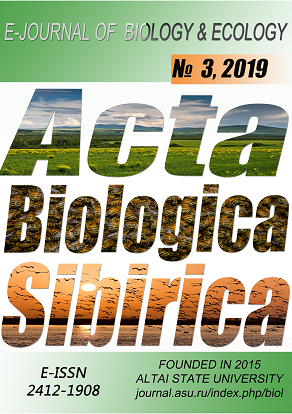Abstract
The paper presents an annotated list of Jewel beetles of the Tyumen region, consisting of 30 species of 12 genera. Ten species: Dicerca amphibia Marseul, 1865, Lamprodila decipiens (Gebler, 1847), Poecilonota variolosa (Paykull, 1799), Chrysobothris affinis (Fabricius, 1794), Agrilus fleischeri Obenberger, 1925, A. mendax Mannerheim, 1837, A. cyanescens (Ratzeburg, 1837), A. ribesi Schaefer, 1946, A. delphinensis Abeille de Perrin, 1897, and A. pratensis (Ratzeburg, 1837) are recorded here for the first time in the region.
References
Akiyama, K., Ohmomo, S. (1997). A check list of the Japanese Buprestidae. Mushi, Supp. 1, 1–67.
Bílý, S. (2002). Summary of the bionomy of the Buprestid beetles of Central Europe (Сoleoptera, Buprestidae). Acta Entomologica Musei Nationalis Pragae, Suppl. 10, 1–104.
Bukhkalo, S.P., Galich, D.E., Sergeeva, E.V., Alemasova, N.V. (2011). Synopsis beetle fauna of the southern taiga of Western Siberia (in the basin of the lower Irtysh). Mosсow: KMK, 1–267 (In Russian).
Catalogue of Palaearctic Coleoptera. (2016). Scarabaeoidea – Scirtoidea – Dascilloidea – Buprestoidea – Byrrhoidea. 3. I. Löbl, D. Löbl (eds). Leiden; Boston: Brill, 432–574.
Gerasimov, A.G., Gerasimova, A.A., Subbotin, A.M. (2015). Overview of the entomofauna of the vicinity of the village of Batovo, Khanty-Mansi Autonomous Okrug. Arktika, Subarktika: mozaichnost, kontrastnost, variativnost kriosfery. Trudy mezhdunarodnoy konferentsii. Tyumen, 62–64 (In Russian).
Hass, R.W., Kubach, J. (2015). Zur taxonomischen Stellung von Dicerca furcata (Thunberg, 1787) und Dicerca aino Lewis, 1893 (Coleoptera: Buprestidae). Entomologische Zeitschrift. Schwanlend, 125(3), 171–174.
Jacobson, G.G. (1905–1915). Beetles of Russia and Western Europe. St. Petersburg: Edition оf A.F. Devrien, 770–800 (In Russian).
Jendek, E., Grebennikov, V. (2011). Agrilus (Coleoptera, Buprestidae) of East Asia. Prague, Jan Farkač, 1–362.
Kolosov, Yu.M. (1914). A note on insects of the Tobolsk province. Zapiski Uralskogo obshchestva lyubiteley yestestvoznaniya. Yekaterinburg, 34(1–2), 13–36 (In Russian).
Kolosov, Yu.M. (1933). Materials for the insect fauna of the Tobolsk North. Trudy Uralskogo oblastnogo instituta mikrobiologii i epidemiologii, 1(1), 49–58 (In Russian).
Koltunov, E.V., Zinovyev, E.V., Zalesov, S.V., Gilev, A.V. (2009). Flora and fauna of the Samarovsky Chugas Natural Park. Entomofauna. Yekaterinburg. 1–178 (In Russian).
Kondinskiye Lakes Natural Park. (2012).V.M. Kalinin (eds.). Yekaterinburg, 1–398 (In Russian).
Korshunov, Yu.P. (1973). To the entomofauna of the north of the middle taiga of Western Siberia. Priroda taygi Zapadnoy Sibiri. Novosibirsk: Nauka, 136–151 (In Russian).
Levykh, A.Yu. (2003). On the question of insect fauna of the Ishim district. Zapadnosibirskoe kraevedenie. Nauchno-informativnyj sbornik. Ishim, 5, 183–190 (In Russian).
Olshvang, V.N. (1977). Biomass and population dynamics of arthropod of mesofauna in Priobye forest-tundra. Biotsenoticheskaya rol' zhivotnykh v lesotundre Yamala. Sverdlovsk, 31–71 (In Russian).
Olshvang, V.N. (1980). Insects of the Polar Urals and Priobye forest-tundra. Fauna i ekologiya nasekomykh Priobskogo Severa. Sverdlovsk, 3–37 (In Russian).
Olshvang, V.N. (1992). The structure and dynamics of the insect population of South Yamal. Yekaterinburg: Nauka, 1–104 (In Russian).
Richter, A.A. (1949). Buprestidae. Fauna SSSR. Zhestkokrylye. Moscow; Leningrad, 13(2), 1–259 (In Russian).
Richter, A.A. (1952). Buprestidae. Fauna SSSR. Zhestkokrylye. Moscow; Leningrad, 13(4), 1–234 (In Russian).
Shukhov, I.N. (1914). The Shchuchya River. Geographical description of the river and travel to its valley in 1913.Yezhegodnik Tobol'skogo gubernskogo muzeya, 22, 1–31 (In Russian).
Volkovitsh, M.G. (2009). Fam. Buprestidae. Insects of Lazovsky Nature Reserve. Vladivostok: Dalnauka, 132–137 (In Russian).
Volkovitsh, M.G. (2013). Annotated catalogue of the Buprestidae of the fauna of Russia. Availalble from: https://www.zin.ru/animalia/coleoptera/rus/bupcatru.htm/
Zinovyev, E.V., Ryabitsev, A.V. (2000). To the fauna of beetles of Siberian Uvaly (Western Siberia). Materialy k poznaniyu fauny i flory Yamalo-Nenetskogo avtonomnogo okruga. Nauchnyy vestnik. Salekhard, 4(2), 51–55 (In Russian).
Zinovyev, E.V., Nesterkov, A.V. (2003). Species composition of beetles (Insecta: Coleoptera) of the Siberian Uvaly Conservation and Natural Park. Ekologicheskiye issledovaniya vostochnoy chasti Sibirskikh Uvalov. Sbornik nauchnykh trudov ZPP Sibirskiye Uvaly. Nizhnevartovsk, 83–118 (In Russian).
Zinovyev, E.V., Olshvang, V.N. (2003). The beetles of the north of the West Siberian Plain, the Subpolar and Polar Urals. Biologicheskiye resursy Polyarnogo Urala. Nauchnyy vestnik, 3(2), 37–60 (In Russian).
Acta Biologica Sibirica is a golden publisher, as we allow self-archiving, but most importantly we are fully transparent about your rights.
Authors may present and discuss their findings ahead of publication: at biological or scientific conferences, on preprint servers, in public databases, and in blogs, wikis, tweets, and other informal communication channels.
ABS allows authors to deposit manuscripts (currently under review or those for intended submission to ABS) in non-commercial, pre-print servers such as ArXiv.
Authors who publish with this journal agree to the following terms:
- Authors retain copyright and grant the journal right of first publication with the work simultaneously licensed under a Creative Commons Attribution License (CC BY 4.0) that allows others to share the work with an acknowledgement of the work's authorship and initial publication in this journal.
- Authors are able to enter into separate, additional contractual arrangements for the non-exclusive distribution of the journal's published version of the work (e.g., post it to an institutional repository or publish it in a book), with an acknowledgement of its initial publication in this journal.
- Authors are permitted and encouraged to post their work online (e.g., in institutional repositories or on their website) prior to and during the submission process, as it can lead to productive exchanges, as well as earlier and greater citation of published work (See The Effect of Open Access).

